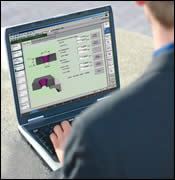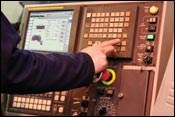Remote CNC Access And Operation
An all-hardware interface grants real-time access to CNC functions via the Internet without taxing the machine's brainpower.
Share



Remote Machining melds two seemingly antithetical concepts—control and freedom—so that shops can do some reconnaissance work or tweak parameters on their own terms. The manufacturer’s self-titled, all-hardware interface grants real-time access to all CNC functions via the Internet so that shop personnel can manipulate the process, regardless of their proximity to the actual machine.
Operators can edit programs, check cut progression or troubleshoot from any PC—be it in a hotel lobby or a home office—as long as there is Internet connectivity. The interface assuages logistical concerns for the user without taxing the machine’s brainpower. It consists of an adapter and a centralized controller, which are completely independent of software, operating system or controller type. The virtual “spy” does not encumber the CNC. Rather, it gains access by splicing into the I/O from the controller side. In essence, the machine is not even cognizant of this “spy.”
“The product is piggybacking, not taxing the control with extra functions,” explains Tim Zott, president of Remote Machining (West Bloomfield, Michigan).
The product is compatible with machining centers, grinding machines, lasers, lathes, plasma cutters, waterjets, EDMs and other CNC-controlled machines. Thus far, it has been predominantly adopted in EDMs because they are generally run unattended more frequently than other machines. Makino offers the interface as a third-party option for its wire and ram EDMs.
Basic shopfloor requirements are at least one PC with Internet connectivity in the building and a LAN connection (within cabling distance) to the machine. Shop personnel can log on to their company’s own internal infrastructure to tinker with certain parameters and functions, but in such a way that does not interfere with the integrity of the process. All modifications must be in accordance with OSHA regulations, which stipulate that axes cannot move without an interlock system. Thus, Mr. Zott says, users can’t execute changes that cause direct movement of the cutting axes outside of what is specified in the loaded program. They can, however, check in periodically to see if alarms have been triggered or to gauge overall machining efficiencies and possibly make adjustments.
“With EDMs, for instance, the shop could modify cutting parameters remotely,” explains Brian Pfluger, Makino senior applications engineer. “Although it can’t start the machine, the shop could edit the speeds and feeds and power elements, as well as halt production.”
From an application support standpoint, the product can better equip engineers to bridge the gap between perceptions of what is going on with the reality of what is actually occurring at the machine. Mr. Pfluger says the system is beneficial when providing technical assistance and when training new users, especially during the first year of machine ownership.
“This often helps us make machining adjustments so that the customer’s part is running more efficiently,” he comments.
This first year of ownership, Mr. Zott says, typically represents the highest incurrence of costs related to technical services and support as well as machine downtime. This product can ease some of those expenses.
“Now, a 15-minute conversation might suffice instead of the lengthy and often frequent exchanges between the application engineers and new machine users,” he says. “The manufacturer’s engineer need only log-in through a secure access port to view the CNC screen and adjust parameters—all of this can be done live with the machine operator logged on as well.”
Related Content
Royal Products Introduces Versatile Three-Jaw Chuck
IMTS 2024: Royal Products features a Three-Jaw Chuck for CNC workholding, designed to reduce setup time between jobs and for the utilization of a range of top tooling.
Read MoreContinuous Improvement and New Functionality Are the Name of the Game
Mastercam 2025 incorporates big advancements and small — all based on customer feedback and the company’s commitment to keeping its signature product best in class.
Read MoreAdvanced Tool Paths, Simple Implementation
Programming advanced tool paths used to be a complex, time-consuming task. Canned cycles in CAM software have now made them more accessible than ever.
Read MoreSetting Up the Building Blocks for a Digital Factory
Woodward Inc. spent over a year developing an API to connect machines to its digital factory. Caron Engineering’s MiConnect has cut most of this process while also granting the shop greater access to machine information.
Read More


























